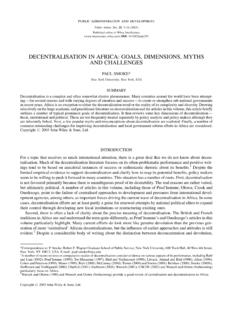Transcription of Chapter One FISCAL DECENTRALISATION: AN OVERVIEW
1 Chapter One FISCAL decentralisation : AN OVERVIEW 1. Introduction This Chapter sets the stage for the substantive discussion of FISCAL decentralization that will follow in the remainder of the handbook. It provides an OVERVIEW of FISCAL decentralization for UNDP Officers involved in policy debates on restructuring intergovernmental FISCAL systems. In doing so, the Chapter , first, defines the concept and pillars (or building blocks) of FISCAL decentralization, and also describes the advantages and disadvantages of undertaking FISCAL decentralization reform. Following, it proposes a user-friendly methodology to be used to successfully carry out FISCAL decentralization reform.
2 Lastly, the paper advises the practitioners of the indicators commonly used to measure FISCAL decentralization. Defining FISCAL decentralisation In the last two decades, over eighty five countries all around the world have embarked on FISCAL decentralization efforts for effective public sector reform management. Indeed, it is important to clarify the concept of FISCAL decentralization, as well as its various components. There are distinct dimensions to decentralization. These can be categorized as the political, administrative and FISCAL dimensions. Each dimension has unique characteristics, objectives and conditions for success.
3 In general terms, the political component refers to the transfer of authority from central to local authorities, the administrative component speaks to the transfer of functional responsibilities from central to local authorities and the FISCAL component addresses to the financial relationship between all levels of government. At the same time while it is useful to distinguish between the different components of decentralization for the purpose of highlighting its many facets, there is nonetheless considerable overlap between all the components. For instance, in order for economic gains from decentralization to be actualized, it is necessary to have had political decentralization in terms of decision-making authority.
4 However, while it is possible that in one case all of these aspects of decentralisation may operate simultaneously, in another case, it is equally possible that a country may be de- centralised in one or two respects, while less so in others. FISCAL decentralization refers to the public finance dimension of intergovernmental relations. It specifically addresses the reform of the system of expenditure functions and revenue source transfers from the central to sub-national governments. It is a key element of any decentralization programme. Without appropriate FISCAL empowerment, the autonomy of sub-national governments cannot be substantiated and, in this way, the full potential of decentralization cannot be realized.
5 1. This Chapter was prepared by Nicoletta Feruglio, December 2007. The Chapter was prepared by the author in her capacity of FISCAL decentralisation Advisor at the UNDP Bratislava Regional Centre The pillars or building blocks of FISCAL decentralization2. Assignment of expenditure responsibilities The box below summaries the key features of the issue of the assignment of expenditure responsibilities. Definition: Assigning expenditure responsibilities refers to the distribution of functions among the different government levels. Why is the allocation of expenditure responsibilities an important issue?
6 : Financing should follow functions. In addition, it is important to clearly define the assignment of expenditure responsibilities in order to enhance accountability (who is responsible for what), avoid unproductive overlap, duplication of authority and legal challenges. A clear definition of the role of the public sector should be established before expenditure responsibilities can be assigned. Which level of Government should be responsible for specific function and activities belonging to the public sector (central, regional and local). Basic Principles for Expenditure Assignment: Efficiency Criteria or Subsidiarity principle: Providing goods and services at the lowest level of government that can efficiently deliver the good or service Service or Benefit Area: Delivering Services across political boundaries Economies of Scale: The extent to which the provision of a service at a smaller or larger scale affects the cost of the service Cultural Values: Some services, such as education and health, may have a high cultural value and requires more centralized or controlled delivery Size and Diversity.
7 Geographic and population size and diversity may affect expenditure assignment 2. Each of the pillars or building blocks of FISCAL decentralization will be extensively discussed in the four remaining chapters No Single Best Assignment, the changes in cost, technology and cultural values may change expenditure assignment The Clear Choice: National vs. Local Public Goods National Public Goods: National Defense, Macroeconomic Stability, Distribution Local Public Goods: Municipal Services ( waste collection, water distribution etc.). The problem: Most goods do not fit these extreme categories (especially health and education).
8 Most goods must be evaluated on a multi-dimensional basis (producing a good or delivering a service; providing or administering the service; financing a service;. setting standards, regulations or policies guiding the provision of government services). Unclear division of functions by level Economies of Scale/Spillovers Assignment might change over the time Expenditure Allocation Strategy Recognize why you are where you are Ensure clear and stable allocation of responsibilities Focus on core services, then devolve additional responsibilities incrementally Recognize that the allocation of expenditure responsibilities must be linked to capacity Recognize that sub-national governments are different in terms of population, expenditure capacity and revenue sources in almost every country.
9 This asymmetric decentralization speaks to the need for performance indicators. Phase in additional responsibilities to more competent sub-national authorities Establish a ranking system to classify the sub-national governments on the basis of technical financial, administrative and planning and policy capacities Monitor implementation and adjust as necessary Allocating Revenue Sources The box below summaries the key features of the issue of the allocation of revenue sources among levels of government. Definition: Allocating revenue sources refers to the distribution of financial resources among the different levels of government.
10 Why is the allocating revenue sources to sub-national governments an important issue?: It ensures sub-national autonomy, promotes accountability and ownership, realizes decentralization efficiency gains and facilitates cash flow management Basic Principles in allocating revenue sources: Revenue potential (governments must have taxes that can respond to changes in population, income and inflation, as well as those which can provide a stable revenue base). Economic efficiency (revenue instruments should be structured to minimize economic distortions in investments, production, consumption and local decisions).

















